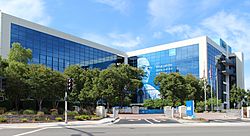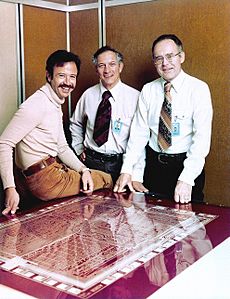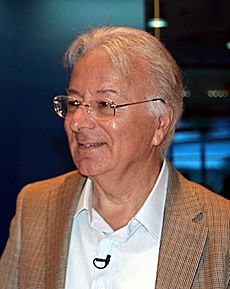Intel facts for kids

Logo since 2022
|
|

Headquarters in Santa Clara, California, in 2023
|
|
|
Trade name
|
Intel |
|---|---|
|
Formerly
|
NM Electronics/ MN Electronics (1968) |
| Public | |
| Industry |
|
| Founded | July 18, 1968 |
| Founders | |
| Headquarters |
,
U.S.
37°23′16″N 121°57′49″W / 37.38778°N 121.96361°W |
|
Area served
|
Worldwide |
|
Key people
|
Frank D. Yeary (chairman) Pat Gelsinger (CEO) |
| Products |
|
| Revenue | |
|
Operating income
|
|
| Total assets | |
| Total equity | |
|
Number of employees
|
131,900 (2022) |
| Subsidiaries |
|
Intel supplies processors for computer system manufacturers such as Apple, Lenovo, HP, and Dell. Intel also manufactures motherboard chipsets, network interface controllers and integrated circuits, flash memory, graphics chips, embedded processors and other devices related to communications and computing.
Intel Corporation was founded on July 18, 1968. The company's name was conceived from the words integrated and electronics. The fact that "intel" is the term for intelligence information also made the name appropriate.
Contents
Processors
- Atom
- Celeron
- Pentium
- Intel Core
- Intel Core 2
- Intel Core i3
- Intel Core i5
- Intel Core i7
Customers
In 2022, Dell accounted for about 19% of Intel's total revenues, Lenovo accounted for 12% of total revenues, and HP Inc. accounted for 11% of total revenues. As of August 2021, the US Department of Defense is another large customer for Intel.
According to IDC, while Intel enjoyed the biggest market share in both the overall worldwide PC microprocessor market (73.3%) and the mobile PC microprocessor (80.4%) in the second quarter of 2011, the numbers decreased by 1.5% and 1.9% compared to the first quarter of 2011.
Intel's market share decreased significantly in the enthusiast market as of 2019, and they have faced delays for their 10 nm products. According to former Intel CEO Bob Swan, the delay was caused by the company's overly aggressive strategy for moving to its next node.
Manufacturing locations
Intel has self-reported that they have wafer fabs in the United States, Ireland, and Israel. They have also self-reported that they have assembly and testing sites mostly in China, Costa Rica, Malaysia, and Vietnam, with only one assembly and/or testing site in the United States.
History
Intel was founded in Mountain View, California, on July 18, 1968, by Gordon E. Moore (known for "Moore's law"), a chemist, Robert Noyce, a physicist and co-inventor of the integrated circuit and Arthur Rock, an investor and venture capitalist.
At its founding, Intel was distinguished by its ability to make logic circuits using semiconductor devices. The founders' goal was the semiconductor memory market, widely predicted to replace magnetic-core memory.
When Intel produced the first commercial metal–oxide–semiconductor field-effect transistor (MOSFET) silicon gate SRAM chip, the 256-bit 1101, it became a bestseller and replaced core memory in many applications.
Intel's business grew during the 1970s as it expanded and improved its manufacturing processes and produced a wider range of products, still dominated by various memory devices.
Intel created the first commercially available microprocessor, the Intel 4004, in 1971. The microprocessor represented a notable advance in the technology of integrated circuitry, as it miniaturized the central processing unit of a computer, which then made it possible for small machines to perform calculations that in the past only very large machines could do. Considerable technological innovation was needed before the microprocessor could actually become the basis of what was first known as a "mini computer" and then known as a "personal computer". Intel also created one of the first microcomputers in 1973.
Intel opened its first international manufacturing facility in 1972, in Malaysia. By the early 1980s, its business was dominated by DRAM chips. However, increased competition from Japanese semiconductor manufacturers had, by 1983, dramatically reduced the profitability of this market. The growing success of the IBM personal computer, based on an Intel microprocessor, was among factors that convinced Gordon Moore (CEO since 1975) to shift the company's focus to microprocessors and to change fundamental aspects of that business model. Moore's decision to sole-source Intel's 386 chip played into the company's continuing success.
By the end of the 1980s, Intel embarked on a 10-year period of unprecedented growth as the primary (and most profitable) hardware supplier to the PC industry, part of the winning 'Wintel' combination. Moore handed over his position as CEO to Andy Grove in 1987. By launching its Intel Inside marketing campaign in 1991, Intel was able to associate brand loyalty with consumer selection, so that by the end of the 1990s, its line of Pentium processors had become a household name.
After 2000, growth in demand for high-end microprocessors slowed. Competitors, most notably AMD (Intel's largest competitor in its primary x86 architecture market), garnered significant market share, initially in low-end and mid-range processors but ultimately across the product range, and Intel's dominant position in its core market was greatly reduced. In the early 2000s then-CEO, Craig Barrett attempted to diversify the company's business beyond semiconductors, but few of these activities were ultimately successful.
Related articles
Images for kids
-
Intel microprocessor facility in Costa Rica was responsible in 2006 for 20% of Costa Rican exports and 4.9% of the country's GDP.
See also
 In Spanish: Intel para niños
In Spanish: Intel para niños







